Root Canal Therapy – Los Gatos, CA
Pain-Free Root Canal Therapy
When you’re suffering from a severely infected tooth that can’t be treated with any other restorative means, extraction might start to seem like the only option. Our dental team is happy to offer a saving grace – root canal therapy in Los Gatos, CA. Despite its scary reputation, this procedure’s high success rate has helped countless people maintain their fully natural smiles for many more years to come, and today’s technology and anesthesia options have rendered it no more uncomfortable than receiving a common filling.
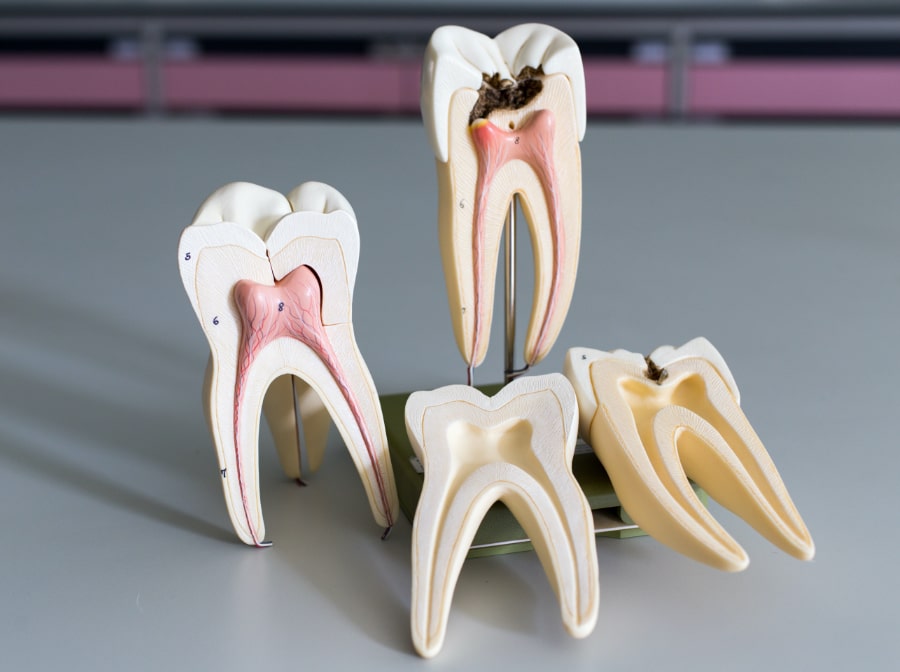
Why Choose Los Gatos Dental Group for Root Canal Therapy?
- Dental Sedation Available
- Two Experienced Dentists
- Same-Day Emergency Dental Care
Why Are Root Canals Needed?
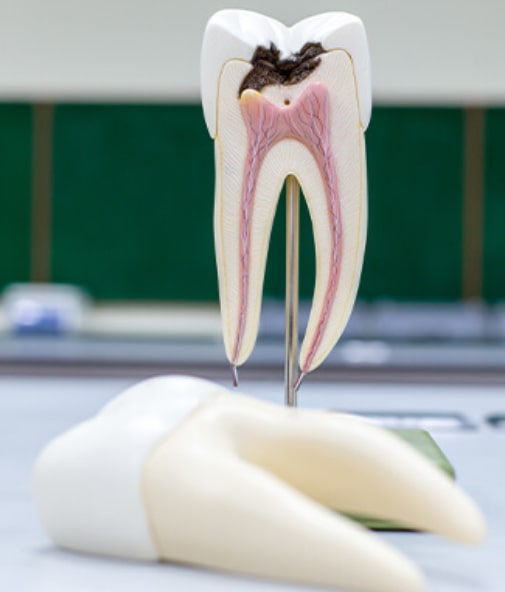
Teeth have nerves and blood vessels in their hollow center, which is known as the pulp chamber. The pulp chamber extends down the length of the roots, through the root canals. Teeth are a unique structure in the human body because the blood supply and immune system have very limited access to the tissue inside of them. The only access that blood vessels have into a tooth is through tiny openings in the tips of the roots, which prevents the immune system from stopping bacterial infections. Once dead, the tissue inside the tooth becomes a food source for bacteria, and the bacteria and dead tissue seep out the tips of the roots, creating an abscess around the root tips. Once this happens, the infected tooth will never get better. The abscess will eventually destroy enough bone around the tooth that it will become loose and be lost. Placing people on antibiotics is a temporary fix. The infection will continue as long as there is dead tissue within the tooth. We can prevent this tooth loss by performing root canal therapy. During the root canal, we’ll remove all of the bacteria and dead tissue within the tooth. We’ll then rebuild the structure of the tooth with a substance called gutta percha and top it off with a dental crown so you can continue using it as you normally would.
Tooth Infections & How They Form
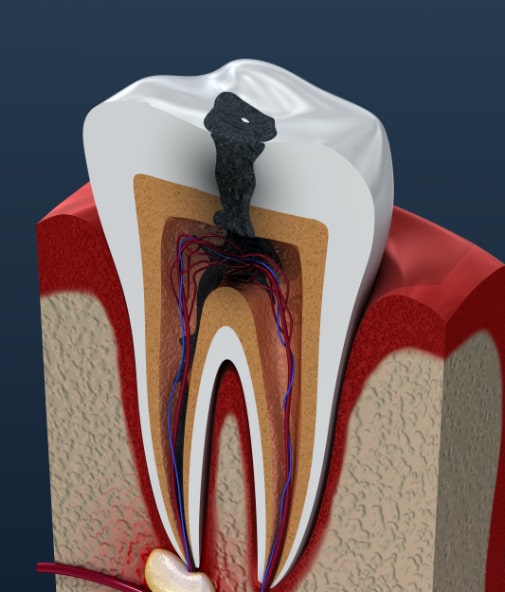
The tissue inside teeth can die and become infected in different ways. The most common is from tooth decay. Cavities are caused by bacteria, and when a cavity gets deep enough and the bacteria gets into the pulp chamber, pulpal infection and tissue death follow.
Trauma can also cause the pulpal tissues to die. Trauma is defined as anything which is irritating to the pulpal tissues and includes cavities, injury (biting on something hard, being hit by something), cracks or fractures, and dental work. Trauma causes inflammation and swelling of the pulpal tissues. If the swelling becomes too intense, it can cut off the blood supply to the pulpal tissues and cause tissue death. Since dental work is traumatic to teeth, it is very important to identify and treat decay as soon as possible. The deeper we have to go inside a tooth to remove decay, the more trauma we cause the tooth. It is also important to keep the size of a restoration as minimal as possible, which is why we use white composite fillings instead of silver amalgams, and inlays and onlays instead of crowns whenever possible.
The Root Canal Procedure
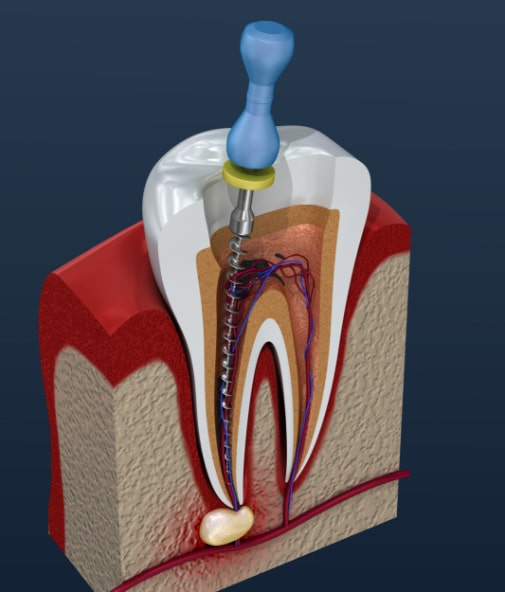
There are two basic steps to a root canal, cleaning the inside of the tooth (called "shaping") and filling the inside of the tooth. After the tooth is numbed, an entry way is created so your dentist can access the inner chamber, where the pulp is located. Once inside, the openings to the canals (one to four, depending on the tooth) are located and cleaned out using instruments called files. The files clean out the inside of the canals and remove dead tissue. We’ll then clean the canals with an antimicrobial rinse to make sure that no bacteria are left behind. Once the canals are fully cleaned, they are dried and filled with a rubbery material that seals up the little hole at the tip of the root, so nothing can get back inside your tooth.
If there is a large abscess present, we sometimes place you on antibiotics for a week before filling the canals. This is done so we do not trap any bacteria inside our root canal filling. We may refer you to a root canal specialist, called an Endodontist, if there are any unusual circumstances such as curved roots, extra roots, or extremely small canals.
Placing the Dental Crown
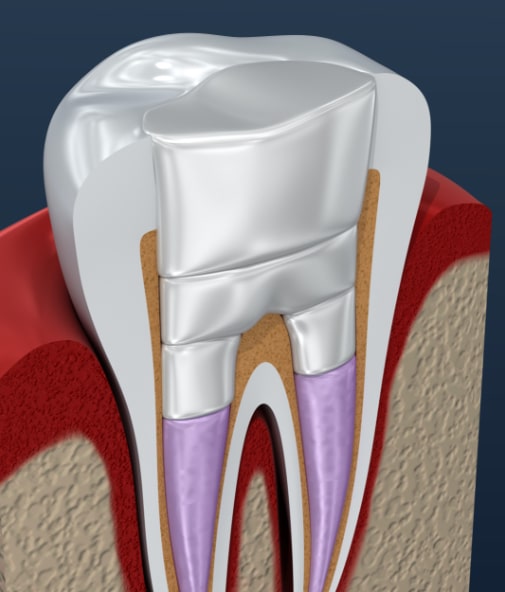
Once a tooth has had a root canal, a crown quickly needs to be placed on it. Now that the tooth has been hollowed out, it is fairly fragile and prone to fracturing. Unlike fillings, inlays, and onlays, crowns cover the entire tooth and are the only acceptable restoration for a tooth which has had a root canal. If you are not planning on placing a crown on your tooth after a root canal, you may as well have skipped the root canal and had the tooth extracted. We cannot stress enough that a tooth which has had a root canal and does not have a crown placed is doomed to develop a serious fracture which will require extraction of the tooth. It may not happen right away, but eventually it will, and we cannot predict how long that will be.
